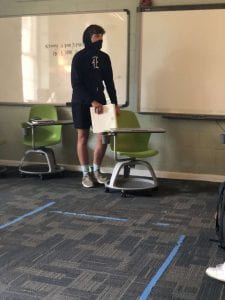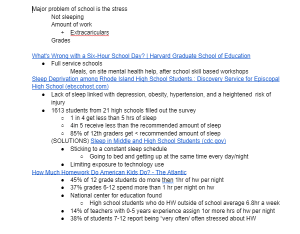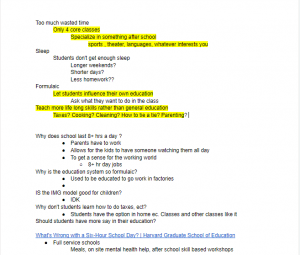Final blog post
Original Idea
The problem that I found with school is stress. I decided to research the idea of stress because I find myself often stressed by school. I found that students in schools all over the country are stressed about pleasing their parents, preparing for college, and getting good grades. This type of stress can cause depression, general anxiety disorder, sleep disorders, social anxiety, substance abuse, and addiction. We could help manage this stress by giving the students less homework, finding a way to get them more sleep, and mandatory counseling, so I began to research. While researching homework, I found that 37% of students in grades 6-12 found themselves doing more than one hour of homework per night, and students who don’t do homework at school do 6.8 hours of homework per week. Also, 38% of students grades 7-12 find themselves often highly stressed out by homework. I also found that students were not getting enough sleep. One in four students get less than 5 hours of sleep per night, and 85% of 12th grade students get less than the recommended amount of sleep.
Major steps
We had 6 workdays in class where I did most of my work.
During this workday, I spent my time brainstorming. Then, I came up with questions to help me research. After I brainstormed and got my questions, I began to research. I found a Harvard article that I thought would be useful, but I did not use it.
On day two, I defined my problem. I found that stress was the main problem with school. I decided to work on this problem through personal experience. I found that my workload piled on top of extracurricular activities and no sleep caused me to be highly stressed. As I found my problem, I started to research more specifically. Finally, I found a source about sleep deprivation that I ended up using.
On this day, I gathered data on workload and sleep in high school students. I found data from many different sources. I used this research to begin thinking about a way to reduce stress in the American school system.
This workday, I talked to Mrs. Gillory, Mrs. Duke, and Mrs. Purnell about my project. They gave me some good ideas about homework times and how it works at Episcopal, thirty minutes for a standard class and forty-five for an AP or Honors class. I also found another source about the positive effects of naps in the workplace.
Day five was used for prototyping my idea. The prototype I came up with was a teacher handbook. The handbook would include the information that I found in my research and my solution to the problem I defined on day two. I also said that I would build a new room model, but I scrapped that idea.
Outside of class
Outside of class between workday five and workday six, I came up with my solutions. They were to reduce homework time, get students more sleep, and require counseling for students.
This was a continuation of day five. I finished most of the handbook in class this class period. I typed the last paragraph at home, and I implemented my final reading book to show my new homework ideas.
After test
After I tested my solutions in class, my classmates’ questions showed some holes in the plan. The first suggestion was about my counseling solution. I initially thought that the college counselors would help the students in their mandatory counseling. They would help the students with their homework plan, and if they found any mental health issues, they would suggest a professional to help them. After my test, I received a suggestion that this job was more suitable for their advisory teacher. I agree with this and think it is a better solution because the counselors wouldn’t have as much on their plate. The advisory teachers only have about ten students, while if we gave this job to the college counselors, they would have twenty to thirty students to help. That’s why I would change my solution to giving this job to the advisory teachers.
The second hole in my plan was about my homework suggestion. I suggested that teachers of non-AP or Honors classes would be allowed to give no more than 25 minutes of homework per night, and Honors and AP classes would be allowed 45 minutes of homework per night. After testing, it was brought to my attention that AP classes might need more than 45 minutes of homework per night because they are college-level courses. However, I feel that 45 minutes is plenty of time for AP students to do the amount of homework they need per night to stay on the set pace. The class also asked about how projects would work. The best solution to this problem would be for the teacher to give class time to do your projects. The teachers could also give thirty minutes of homework when projects are being done.
My third suggestion was to allow students to nap on campus. This is to help students who don’t get the recommended amount of sleep be more productive throughout the day. My classmates pointed out that there are some logistical problems with this solution. They asked questions like, “What if the students oversleep?” Speaking from personal experience, this is not an issue. I have found that the bell or friends wake me up, so I don’t miss my next class. Although this isn’t a problem for me, I can understand how it would be an issue for other students, so to help this problem, I decided to add the rule that if a student sleeps through a class period, they will lose all nap privileges on campus.
What went well, could have gone better, and what I learned.
I felt that the project overall went well. I finished most of my project in class, and I enjoyed thinking about how school as a whole could be better. I also found research that supported my ideas about fixing school, and I felt my solutions were good ideas. Although I liked these ideas, I think that my presentation could have gone better. I didn’t really support my claims with my research, and I felt unprepared to present to the class. I learned that many students are stressed by the same things in school that I am. This made me feel a little better about myself, and it helped me realize that this is a real problem.
Final book
My final book was The Informer by Liam O’Flaherty. This was an exciting book that I enjoyed reading. From the beginning of the year to the end, my reading improved significantly. Reading this book was much less stressful than reading at the beginning of the year. I actually used my suggestions from my project to help me read my book. I read 20 minutes a day for about a week and a half to finish my book. At the beginning of the year, I would have put the book off until I absolutely had to read it, but at the end of the year, I learned that reading the book more spaced out made it easier to read and understand.
Final Thoughts
This class has been quite thorough and informative. I have learned how to manage my time and also improved many skills. I liked that we could decide what we wanted to focus on at the beginning of the year and that we as a class got more say in what we did.





